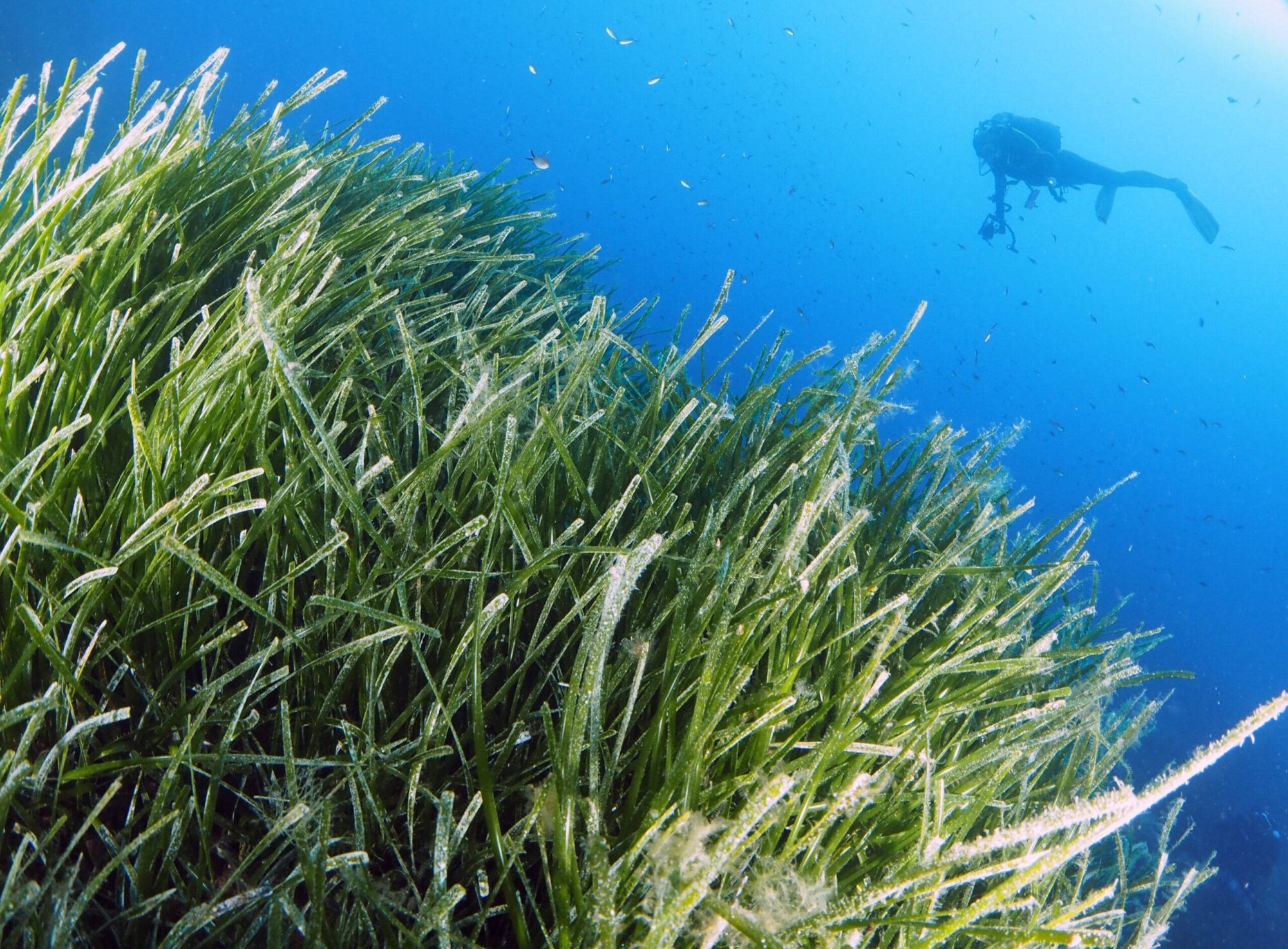We here at Ċirkewwa Marine Park have a deep love for Posidonia oceanica, a humble yet critical component of our marine environment. Posidonia oceanica commonly known as Neptune grass or Mediterranean seagrass is easily overlooked, but this remarkable plant plays a crucial role in maintaining the health and sustainability of marine environments. Currently, we are monitoring the health of this plant within our marine park. We want to see it thrive because if it does so it would increase the biodiversity of the animals here. P. oceanica also plays an important role as a climate regulator through carbon capture, thus helping to reduce the impacts of climate change. Posidonia grows in large meadows that cover the sea floor, creating an ecosystem of great beauty, which can be enjoyed by scuba dividers, snorkelers as well as animals that rely on these meadows for shelter from predators and to acquire their own food supply.
Posidonia oceanica is a seagrass species endemic to the Mediterranean Sea, forming extensive underwater meadows. It covers between 25,000 and 50,000 Km2 of the coastal areas, corresponding to 25% of the sea bottom at a depth between 0 and 40 m. Currently, Posidonia meadows are a protected habitat within the Maltese waters, under the European Union Habitats Directive as part of the requirements for the effective management of protected areas, due to its varied and important roles which we will look at now.
More than half of the oxygen we breathe comes from the sea and Posidonia oceanica has been called “the lungs of the Mediterranean” because it is one of the most important sources of oxygen provided to coastal waters. Posidonia is like the forest – producing oxygen. A study from the Mediterranean Advanced Research Institute (IMEDEA) and the BBVA Foundation states that the Mediterranean Posidonia population produces 14 to 20 liters of oxygen per square meter every day.
Not only does it provide oxygen but Posidonia oceanica is a champion in the fight against climate change. Like terrestrial plants, seagrasses capture and store significant amounts of carbon dioxide (CO2) from the atmosphere through photosynthesis. These meadows act as a carbon sink, absorbing carbon dioxide, and storing carbon at an average rate of 83 g Carbon per m² per year. This process helps mitigate the impacts of greenhouse gas emissions, thus playing a vital role in regulating global climate.
The need to protect these meadows and to allow them to thrive is vital in the fight against climate change. Posidonia is also an indicator of overall water quality as it is sensitive to pollution and can only grow in clean unpolluted waters, another reminder of why we need to keep our waters clean. Posidonia also helps to clean the water and so we can thank it for our crystal clear waters here.
When the meadows are thick and abundant they create a habitable environment for a variety of animals who can use the meadows for breeding, feeding and provide vital nursery grounds allowing more animals to come and live here (Figure 1).
Figure 1: A common stingray resting amongst the Posidonia oceanica meadows in the Cirkewwa Marine Park. Credit, Timothy Zammit for the Ċirkewwa Marine Park
The benefits of Posidonia extend to land as well. Due to the compact and dense structure of these meadows, Posidonia oceanica has a crucial role in stabilizing the seabed when alive, reducing wave action and currents below surface level. It is also a prominent protector of our sandy and rocky beaches by protecting them from coastal erosion. These banquettes (commonly referred to as seagrass mattresses) on our beaches (Figure 2), receive the impact from crushing waves in the winter storms, protecting the rock and sand below it, ultimately preventing rock dissolution and sand loss from the beaches. Moreover, these banquettes of dead leaves that are formed in the winter on the beaches provide nutrients and food for many beach organisms.
I’m sure you can see why we love this amazing plant so much but unfortunately, it is under serious threat, despite international legislation to protect it, like the EU Habitats Directive, and other initiatives. Posidonia oceanica meadows are declining rapidly in many parts of the Mediterranean because of pollution, coastal development, anchoring, and fishing activities. There are simple ways that everyone can help to protect it, such as being aware of the products that we wash down the sink and trying to opt for chemical-free soaps, shampoos, and washing products, always taking litter away from beaches so that they don’t wash into these meadows. If you are a sailor then use installed buoys instead of anchoring, or anchor in Posidonia oceanica-free areas. Finally, go down and have a look at these stunning meadows so that you see the animal life and beauty of it to really inspire yourself and others to take small but important actions to help save this magical plant.
Figure 2: Posidonia oceanica banquette in one of the beaches in Ċirkewwa. Credit: Ċirkewwa Marine Park


